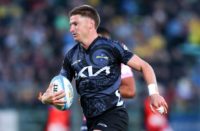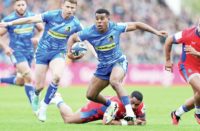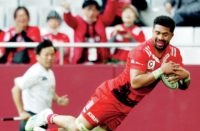 Listening to Stuart Lancaster talk about his England rugby team, the words are pretty familiar. There's nothing unusual, nothing that makes you start to think he's pushing the boundaries with this squad of players, because its all pretty basic managerial blurb.
Listening to Stuart Lancaster talk about his England rugby team, the words are pretty familiar. There's nothing unusual, nothing that makes you start to think he's pushing the boundaries with this squad of players, because its all pretty basic managerial blurb.
That's why I'm praying that there are things happening in a practical way on the training paddock for the series against South Africa that we are not hearing about – because England need to start moving their game in the same direction as Harlequins, not Saracens, particularly against the strength of the Springboks.
I enjoyed the Baa-baas game, and if that's a signal of England's intention then they are looking pretty good. It takes so much bottle to play the way the likes of Leinster, Quins, and most New Zealand teams do, because individual players have to have so much belief to create a team mindset which allows them to become almost telepathic in attack.
The clubs and provinces have a lot of time together to work it out and become comfortable, and the Kiwis have it in their DNA. Lancaster only has a few weeks together at a time, therefore it's much more difficult, and the easiest option is the simple game – kick, run, chase and defend.
I would like to see the England management take a risk and, with Mike Catt in among them with only a three-month contract and nothing to lose, I hope he can persuade them to jump. I'm not talking wholesale backline changes, it wouldn't be right after such a brilliant last three games of the Six Nations, but the changes to me seem obvious.
You pick players on the strength of how they perform for their clubs, clubs play in a certain way, some the same as the national team, some not. It's no surprise when you have a midfield of Saracens that the England backs play like a Saracens backline. It's a tough call but at some stage, maybe on this tour or the autumn internationals, Lancaster has to look at one or two of his inside backs being able to make clean breaks and beat defenders, rather than relying on an overworked pack to do the damage.
Owen Farrell has had a fantastic beginning to his career, showing maturity and control almost beyond his years. However, he's yet to scare defenders with his speed or side-stepping ability, and until he finds that he will be another Jonny Wilkinson, but not as physical. Being 90 percent of Jonny isn't a bad thing, but England need another Will Greenwood to sort the attacking jigsaw, and there isn't one.
If Farrell starts you need to have a threat next to him in the middle, and Manu Tuilagi is that, whether you play him at No.12 or No.13. Tuilagi's quality is he's a threat even from a standing start because he's so explosive, and, although he didn't look at his best against Quins in the Premiership final, moving him to inside-centre could be key to improving England's attacking shape. Brad Barritt has done well at inside centre, but his strengths are more defensive than attacking, and, although it's a tough call on Barritt, it's time to move up a gear and let this England backline deliver all it can.
That's why I hope Catt can get across to Lancaster how much better picking someone like Jonathan Joseph at outside-centre would be for the likes of Foden, Ashton, Strettle and Wade. Joseph's natural game is to attack, like the rest of the back three. They think the same way, act the same way, and all want to score tries.
Another inside-centre option is Jordan Turner-Hall. Against Tigers last weekend his involvement for Tom Williams' try was him at his best, and something we need to see more of. Harlequins attacked off lineout ball and from the breakdown Turner-Hall came onto it at speed, attacked flailing arms, and knocking a big dent in the Tigers defence. With Quins getting quick ball again following George Robson's line-break, the overlap was created, and, after Danny Care found Mike Brown hitting the line from deep, Williams was in the clear to score a very good try.
Turner-Hall is at his most effective running hard from deep at pace, crashing past defenders or sucking them in, and creating quick ball for the Fancy Dans outside. Calling a lot of the shots alongside him is Nick Evans, a very experienced All Black fly-half who has attacking rugby hard-wired in to him, and has always pretty much played the same way all his rugby career.
England's fly-half choices are not quite as hard-wired in attack as Evans. When Toby Flood is back to full fitness he will challenge Farrell, because, until Farrell can play in the face of the defence carrying the ball, he won't be a threat as an attacker. Flood is a more natural attacker than Farrell, but he can't step up until he's 100 percent mentally and physically ready, which will probably be near the end of tour.
So, for the Durban Test you have to pick Farrell at No.10, unless you delay his progression and pick Charlie Hodgson. As good a player as Charlie is, I wouldn't have taken him. I'd have another young gun, putting pressure on Farrell and Flood in training, with the verbals and banter off-field that's part of it. Hodgson's inclusion typifies Lancaster's so far pragmatic ‘softly softly' approach. You can't knock his planning because of the steady progression in the Six Nations – but not many world-class teams have had a dormant No.10 in attack, and the exceptions have had an outstanding pairing at No.12 and No.13.
Lancaster might get it right if he lets Catt have his way in attack, but for the start of the South Africa tour I don't expect him to move away from his Six Nations midfield trio of Farrell, Barritt and Tuilagi. However, at the very least I would like to see Joseph on the bench, so he could be tried outside Tuilagi.
2 Comments
Leave a Comment
You must be logged in to post a comment.



























Pingback: elephant thai camp
Pingback: รีวิว เว็บหวยออนไลน์ lotto88win